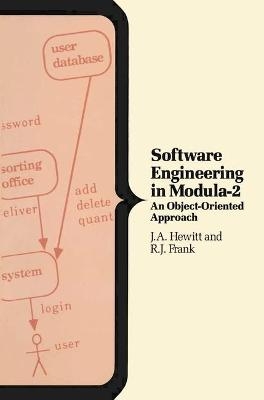
Software Engineering with Modula-2
An Object Oriented Approach
Seiten
1989
Palgrave Macmillan (Verlag)
978-0-333-51518-1 (ISBN)
Palgrave Macmillan (Verlag)
978-0-333-51518-1 (ISBN)
- Titel ist leider vergriffen;
keine Neuauflage - Artikel merken
This book introduces Modula-2 through an object-oriented programming approach which has been developed over the past five years on the BSc and MSc Computer Science courses at Hatfield Polytechnic. It is aimed at beginners in programming following an undergraduate course and as a self-study text.
This book introduces Modula-2 through an object-oriented programming approach which has been developed over the past five years on the BSc and MSc computer science courses at Hatfield. Chapter 1 introduces the main features of Modula-2 through an example program, whilst chapter 2 introduces the concepts required for object-oriented program design. All the essential high level features of the language are covered in some detail in chapters 3 to 8. Chapter 9 explores the main attributes of an object-oriented language and considers to what extent these features are represented in Modula-2. Chapters 10-12 develop object-oriented solution to simple example through the implementation of some of these features. The low level features of the language are discussed in chapter 13, and chapter 14 extends these features to discuss the implementation of basic operating system functions in Modula-2. This book is suitble for beginners in programming following an undergraduates in computer science and as self-study text for more experienced high-level language programmers who wish to learn Modula-2 in the context of an object-oriented approach.
We recommend read and implement the example program in chapter 1 then read chapter 2 to obtain a flavour of object oriented design; however they should leave a full study of the example program in chapter 2 until they have become fully familiar with the material in chapters 3 to 8. The more experienced programmer may not need to implemten the program in chapter 1 but should carefully study the example in chapter 2 where a distinction between more traditional functional decomposition and the object-oriented approach is explored in some detail.
This book introduces Modula-2 through an object-oriented programming approach which has been developed over the past five years on the BSc and MSc computer science courses at Hatfield. Chapter 1 introduces the main features of Modula-2 through an example program, whilst chapter 2 introduces the concepts required for object-oriented program design. All the essential high level features of the language are covered in some detail in chapters 3 to 8. Chapter 9 explores the main attributes of an object-oriented language and considers to what extent these features are represented in Modula-2. Chapters 10-12 develop object-oriented solution to simple example through the implementation of some of these features. The low level features of the language are discussed in chapter 13, and chapter 14 extends these features to discuss the implementation of basic operating system functions in Modula-2. This book is suitble for beginners in programming following an undergraduates in computer science and as self-study text for more experienced high-level language programmers who wish to learn Modula-2 in the context of an object-oriented approach.
We recommend read and implement the example program in chapter 1 then read chapter 2 to obtain a flavour of object oriented design; however they should leave a full study of the example program in chapter 2 until they have become fully familiar with the material in chapters 3 to 8. The more experienced programmer may not need to implemten the program in chapter 1 but should carefully study the example in chapter 2 where a distinction between more traditional functional decomposition and the object-oriented approach is explored in some detail.
Introduction to Modula-2 - Modular Programming: An Object Oriented Approach - Simple Data Types and Expressions - Control Structures - Procedures and Functions - Scope Rules - Structured Data Types - Files and File Handling - Dynamic Data Structures - Object-Oriented Programming - Implementing Object Classes with Transparent Abstract Data Types - Implementing Object Classes with Opaque Abstract Data Types - Implementing Inheritance: Generics - Case Studies - Accessing Hardware Objects - Concurrent Programming - Appendix A: Modular-2 Language Definition: EBNF and Syntax Diagrams - Appendix B: Library Modules - Appendix C: Proposed Changes to Modular-2 - Index
| Erscheint lt. Verlag | 2.11.1989 |
|---|---|
| Reihe/Serie | Computer Science S. |
| Zusatzinfo | index |
| Verlagsort | Basingstoke |
| Sprache | englisch |
| Maße | 156 x 234 mm |
| Gewicht | 412 g |
| Themenwelt | Mathematik / Informatik ► Informatik ► Programmiersprachen / -werkzeuge |
| Informatik ► Software Entwicklung ► Objektorientierung | |
| ISBN-10 | 0-333-51518-8 / 0333515188 |
| ISBN-13 | 978-0-333-51518-1 / 9780333515181 |
| Zustand | Neuware |
| Haben Sie eine Frage zum Produkt? |
Mehr entdecken
aus dem Bereich
aus dem Bereich
objektorientierte Entwicklung modularer Maschinen für die digitale …
Buch | Hardcover (2024)
Hanser (Verlag)
CHF 62,95
Entwicklung von GUIs für verschiedene Betriebssysteme
Buch (2023)
Hanser, Carl (Verlag)
CHF 55,95
Principles and Practice Using C++
Buch | Softcover (2024)
Addison Wesley (Verlag)
CHF 119,95


